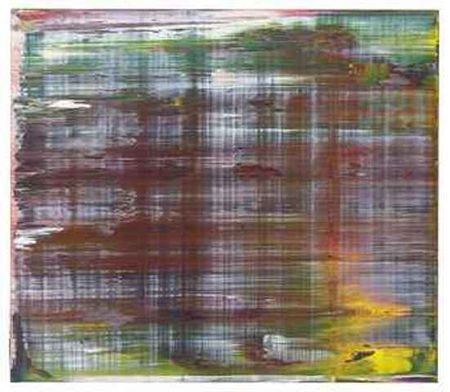Gerhard Richter (b. 1932), Abstraktes Bild
Gerhard Richter (b. 1932), Abstraktes Bild. Photo: Christie's Images Ltd., 2011
signed, numbered and dated '842-7 Richter 1997' (on the reverse), oil on aluminium, 18 7/8 x 21 5/8in. (48 x 55cm.). Painted in 1997. Estimate £200,000 - £300,000. Price Realized £289,250
Provenance: Anthony d'Offay Gallery, London.
Isabel and David Breskin Collection, San Francisco.
Schönewald Fine Arts, Xanten/Anthony Meier Fine Art, San Francisco.
Barbara Mathes Gallery, New York.
Acquired from the above by the present owner.
Literature: Gerhard Richter 1998, exh. cat., London, Anthony d'Offay Gallery, 1998, no. 842-7 (illustrated in colour, unpaged).
'The Elusive Gerhard Richter', in Art Journal Noëma, January- March 1999 (illustrated in colour, p. 47).
R. Storr, Gerhard Richter Malerei, Ostfildern-Ruit 2002 (illustrated in colour, p. 262).
Gerhard Richter Werkverzeichnis 1993-2004, exh. cat., K20 Kunstsammlung Norderhein-Westfalen, Dusseldorf 2005, no. 842-7 (illustrated in colour, unpaged).
D. Elger, Gerhard Richter, Paris 2010 (illustrated in colour, p. 291).
Exhibited: New York, Museum of Modern Art, Gerhard Richter-Forty Years of Painting, 2002 (illustrated in colour, p. 262). This exhibition later travelled to Chicago, The Art Institute of Chicago, 2002; San Francisco Museum of Modern Art, 2003 and Washington, Hirshhorn Museum and Sculpture Garden, 2003.
Notes: "Objects have too much importance...they give the painting too much direction. Colour and structure are not given a chance to stand on their own. Because abstract painting does not represent - there is no man or table or whatever - one must only make sure that the relationship of colour and structure is right" (G. Richter, quoted in 'An Interview', in The Print Collectors Newsletter, vol. 16, September-October 1985, p. 123).
Gerhard Richters Abstraktes Bild is a delightfully equivocal painting from one of the artists' most important bodies of work in which he develops his lifelong painterly investigation into the relationship between colour and structure. At first glance, the diaphanous strata of paint which Richter layers onto the surface of the canvas seem to mask a deep, mysterious interior. These layers seem to both reveal and undermine the perceptual depth contained within the painting, the effect of the squeegeed strips with their myriad of colour and detail is deliberately ambiguous. Seeming to both conceal and reveal at the same time, the push and pull of the stripes provide a pictorial demonstration of Richter's belief that what we call 'reality' is ultimately a fiction, a mere model for understanding the world. Abstraktes Bild is Richter's deliberate attempt to demonstrate that all perception is an illustration. Rather than masking an image, the strong vertical and horizontal lines layered on top of each other simply creates a new, more complete image. Playing with the surfaces of his abstracts, Richter is in effect exploring them in the same way that he explored the ambiguity of blurring in his photographic paintings of the 1960s. As with these works, Richter is clearly still fascinated with surface and the insight it can provide into the mystery of what lies beneath.
Gerhard Richter's Abstraktes Bild was painted in several stages, with a lighter, softer background overlaid with weighty applications of paint that are applied by pulling a squeegee across the surface of the canvas to fracture the paint and produce thinner and increasingly more transparent layers, allowing us to see into the very heart of the work. Unlike the Abstract Expressionists, Richter is more deliberate and conceptual with his application of paint. Indeed, it is the artist's intention to disrupt and deconstruct the painting and by doing so enter a new rhetoric of the medium.
Abstraktes Bild epitomises the concerns that have accompanied Richter's oeuvre throughout his career. For it is only in retrospect that we can assess the continuities which underlie the photorealist paintings, the romantic landscapes, the clouds and the abstract paintings which have successively, since the early 1960s, been the creative articulation of a desire to engage with what it means to be a painter at a time in which the practice of painting is itself constantly being called into question.
Christie's. Post-War and Contemporary Art Day Auction, 17 February 2011, London, King Street www.christies.com

/https%3A%2F%2Fprofilepics.canalblog.com%2Fprofilepics%2F1%2F0%2F100183.jpg)
/https%3A%2F%2Fstorage.canalblog.com%2F03%2F02%2F119589%2F96711876_o.jpg)
/https%3A%2F%2Fstorage.canalblog.com%2F11%2F31%2F119589%2F94773502_o.jpg)
/https%3A%2F%2Fstorage.canalblog.com%2F20%2F83%2F119589%2F94772815_o.jpg)
/https%3A%2F%2Fstorage.canalblog.com%2F26%2F72%2F119589%2F75604929_o.jpg)
/https%3A%2F%2Fstorage.canalblog.com%2F59%2F60%2F119589%2F26458628_o.jpg)



/http%3A%2F%2Fstorage.canalblog.com%2F85%2F41%2F119589%2F129336877_o.jpg)
/http%3A%2F%2Fstorage.canalblog.com%2F49%2F31%2F119589%2F129152682_o.jpg)
/http%3A%2F%2Fstorage.canalblog.com%2F55%2F54%2F119589%2F128978735_o.jpg)
/http%3A%2F%2Fstorage.canalblog.com%2F25%2F57%2F119589%2F128085437_o.jpg)